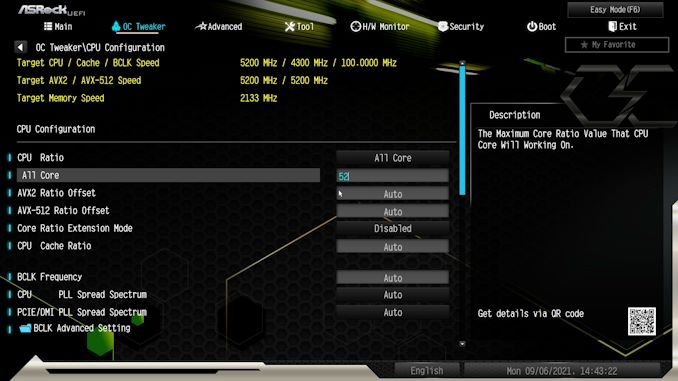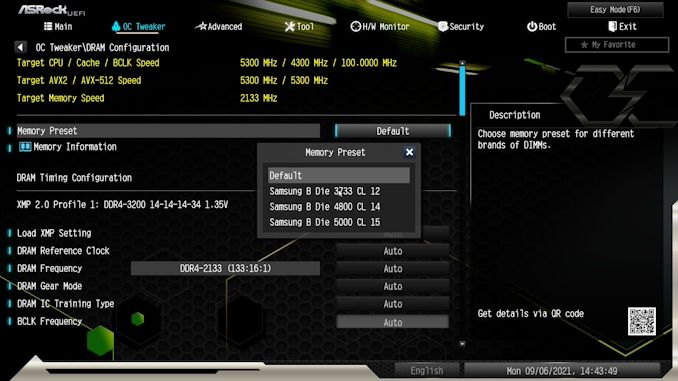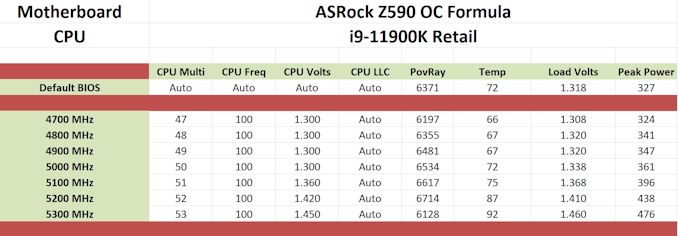The ASRock Z590 OC Formula Review: An Iconic Brand Revival
by Gavin Bonshor on September 10, 2021 9:00 AM ESTOverclocking
The skill of overclocking is one that can take thousands of hours to get to grip with the hardware, software, and then a new processor generation comes along which requires half of it to be learned again! Getting the right combination of settings to deliver an optimized yet stable enough system to deliver the performance can be time-consuming and tedious. Despite the excellent work from both Intel and AMD over the last couple of years with its interpretations of 'turbo' and 'boost,' this doesn't typically affect all of the cores equally, and instead focuses on one or two for that immediate single thread push. On an eight-core processor such as the Intel Core i9-11900K, providing whatever software of application is being used can utilize the cores and threads, typically more performance can be had from pushing all of the cores higher. At present, Intel employs some of the most aggressive methods of automatic overclocking with its Thermal Velocity Boost (TVB), and more recently with Rocket Lake, its new Adaptive Boost Technology (ABT) on its 11th Gen Core i9 K and KF processors.
Perhaps the biggest disadvantage when it comes to overclocking the processor has to deal with the extra thermal and power implications. As Intel pushes its silicon almost to its limit right out of the factory, adequate cooling is needed. Due to previous experiences when overclocking our i9-11900K in previous Z590 reviews, we've seen power consumption figures surpassing 350 W when overclocking, which is a phenomenal amount of wattage for an eight-core chip. Even at default settings, new processors from both Intel and AMD typically run warmer than previous generations. Hence, we recommend using premium cooling solutions such as AIO CPU coolers or even large tower coolers to help manage the extra heat generated. But even with that said, in a good amount of our 11th Gen CPU overclock testing, it hasn't been worth the effort. So it will be interesting to see what the Z590 OCF does here.
Experience with the ASRock Z590 OC Formula
As expected from a board designed for extreme overclockers, the firmware has many options for users to tweak and customize to maximize Intel's Rocket Lake silicon. All of the board's overclocking options can be found within the OC Tweaker section of the BIOS, which can be accessed by selecting the Advanced move by pressing the F6 key.
Using the OC Tweaker to overclock our Core i9-11900K processor, we experienced no problems whatsoever, and all of the CPU, DRAM, and voltage settings are in their own sections. To overclock the processor, users can simply set the CPU Ratio to All-core or overclock individual cores of the processor by selecting the desired ratio. Users can also make adjustments to the AV2 and AVX-512 ratios for better stability when using these specific instruction sets. All of the voltage settings can be found under the relevant submenu, and there's plenty for users to tweak and adjust which is expected from a board of this pedigree.
As well as LN2 overclocking profiles there are also memory presets for users with high-bin Samsung B-Die memory. There are plenty of DRAM options, including power settings, VCCSA load-line calibration settings, and many latency options within the DRAM section. It should be noted that when making any adjustments to the CPU VCore within the firmware, the board will automatically revert the CPU load-line calibration to the most aggressive Level 1 profile.
Our overall experience when using the ASRock Z590 OC Formula was pleasant, and the board has every option that any enthusiast could possibly need to overclock both the memory and CPU. There are no options to overclock Intel's UHD integrated graphics as the board doesn't include any video outputs.
Overclocking Methodology
Our overclocking methodology is as follows. We select the automatic overclock options and test for stability with POV-Ray and Prime95 to simulate high-end workloads. These stability tests aim to catch any immediate causes for memory or CPU errors.
For manual overclocks, based on the information gathered from the previous testing, start off at a nominal voltage and CPU multiplier, and the multiplier is increased until the stability tests are failed. The CPU voltage is increased gradually until the stability tests are passed. The process is repeated until the motherboard reduces the multiplier automatically (due to safety protocol) or the CPU temperature reaches a stupidly high level (105ºC+). Our testbed is not in a case, which should push overclocks higher with fresher (cooler) air.
Overclocking Results
The ASRock Z590 OC Formula does come with a couple of overclocking presets, but all of these are designed for extreme overclockers to use as a foundation to build upon when using sub-ambient cooling methods. As such, we decided not to test these given we test using an AIO cooler which could potentially cause damage to our hardware.
Overclocking our Core i9-11900K manually, we did manage to achieve a maximum stable all-core frequency of 5.3 GHz, however this did hit a limiter causing the performance to decrease, even with a peak temperature of 92ºC observed. Going from 4.7 GHz to 5.2 GHz, we noticed very tight levels of VDroop compared to our CPU VCore values and those we saw at full-load. This is perhaps a consequence that when users set manual CPU VCore in the firmware, it reverts the load-line calibration profile to Level 1 which is the most aggressive profile.
Realistically, for every-day use, our best Core i9-11900K would be run at 5.2 GHz with the temperatures tightly monitored. Going beyond that with more exotic cooling, which unfortunately we are not able to test at this time, would suggest that this is one of the better Z590 boards according to results on the HWBot database.













20 Comments
View All Comments
Oxford Guy - Friday, September 10, 2021 - link
'ASRock's in-house overclocker'Salesman.
Midland_Dog - Saturday, September 11, 2021 - link
yeah no, hes there k|ngp|n the marketing comes with the scores.fatal1ty was more marketing, just used to win games so we will buy his name lmao. to be fair the fatal1ty killer z97x was an awesome board, very very good at ddr3 oc
MDD1963 - Friday, September 10, 2021 - link
At least we are not reviewing Z590 mainboards only 1 month from Z690 launch! (it's a full 2.5 months away yet!) :)Slash3 - Friday, September 10, 2021 - link
That would be the EVGA Z590 Dark review.Midland_Dog - Saturday, September 11, 2021 - link
i appreciate the effort, but this review is quite misguided in a number of ways1) you didnt get 5.3ghz stable, it scored lower than default UEFI settings
2) any board with a decent vrm will hit the same all core OC
3) this board is for memory overclocking, theres no doing an OC segment unless you are going to show just how good it is at 1DPC with Samsung B-Die
now im not a fan of pointless criticism, so im going to try and make this constructive, test this tier of board with a known cpu at its known frequency (5.2ghz for your 11900k sample, it negatively scaled at 5.3ghz, hence a regression and instability) and then from there use a single kit of high binned B-Die to compare the boards. Going from DJR (maxed out) to B-Die (maxed out) is usually a bigger gain than an all core OC
regards, Midland_Dog
defaultluser - Monday, September 13, 2021 - link
Yeah, her number o f subbrands under Asrock right now is an absolute mind-boggling 9! While most of the cheapest enthusiast boards they sell will get you similar performance.This entire gimmick of high-end boards like this is so you can pretend you're going to be a Great Online Influencer (when there's already a saturated lineup out there with it's names plastered to products like these.)
If anything, think half the sub-brands for every major motherboard brand could die overnight, and board sales numbers would continue unabated - this is just an excuse to triple the price some idiot will pay for a motherboard
Midland_Dog - Thursday, September 16, 2021 - link
if you think you are going to run 4000mhz + with cr1 on a 2dpc board you are mistaken. my z390 strix can do 3600mhz MAX with cr1, barely does 4000mhz. this board will happily do 5000mhz cr1 if you know what you are doing, so no, unless its an ITX board it wont oc nearly as well as this. like your talking a solid 15-20GB/s left on the table at 2dpcLinustechtips12 - Thursday, September 16, 2021 - link
I'm gonna be honest the actual design for the board would make an amazing cyberpunk 2077 theme setup.Zayne10 - Friday, September 17, 2021 - link
It's an amazing and very impressive blog. and I must say it really compensate my time during my free time from my business and if you want to know about the UK Search Engines just visit the site. https://www.seocalling.com/leading-search-engines-...Ava Brian - Friday, September 24, 2021 - link
Data Source Hub is of the leading source of latest news, Market intelligence and trends data. This online portal provides a platform for essential latest news.Visit to read more: https://www.datasourcehub.com/